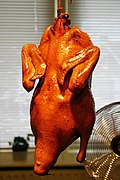Peking duck
Peking Duck is a famous duck dish from Beijing that has been prepared since the imperial era. The meat is characterized by its thin, crisp skin, with authentic versions of the dish serving mostly the skin and little meat, sliced in front of the diners by the cook. Ducks bred specially for the dish are slaughtered after 65 days and seasoned before being roasted in a closed or hung oven.
History
The dish, originally named Shāo yāzi (燒鴨子), has a history of over 600 years. According to the Complete Recipes for Dishes and Beverages manual in 1330 by Hu Sihui, an inspector of the imperial kitchen, the Peking Duck was an imperial dish by the Yuan Dynasty (1271–1368). By the Qing Dynasty, it gained popularity among the upper classes and was one of the main dishes on imperial court menus.
Preparation
The preparation of Peking Duck involves a lengthy process of preparation and cooking. The ducks used are of a specific breed, the White Beijing duck, and they are raised in a free-range environment for the first 45 days of their lives. After this, they are kept in a cage which restricts their movement, to fatten them up.
The ducks are killed after 65 days and air is pumped under the skin to separate the skin from the fat. The duck is then cleaned and hung up to dry in the sun. Once dry, the duck is roasted in an oven, traditionally a hung oven, until it turns shiny and reddish-brown.
Serving
Peking Duck is traditionally carved in front of the diners and served in three stages. First, the skin is served dipped in sugar and garlic sauce. The meat is then served with steamed pancakes (春餅), spring onions and sweet bean sauce. Several vegetable dishes are provided to accompany the meat, typically cucumber sticks.
In popular culture
Peking Duck has been referenced in various aspects of popular culture, including movies, television shows, and songs. It is often used as a symbol of Chinese cuisine and culture.
See also
| Chinese cuisine |
|---|
|
|
| Duck dishes | ||||||
|---|---|---|---|---|---|---|
This duck dishes related article is a stub.
|
Transform your life with W8MD's budget GLP-1 injections from $125.
W8MD offers a medical weight loss program to lose weight in Philadelphia. Our physician-supervised medical weight loss provides:
- Most insurances accepted or discounted self-pay rates. We will obtain insurance prior authorizations if needed.
- Generic GLP1 weight loss injections from $125 for the starting dose.
- Also offer prescription weight loss medications including Phentermine, Qsymia, Diethylpropion, Contrave etc.
NYC weight loss doctor appointments
Start your NYC weight loss journey today at our NYC medical weight loss and Philadelphia medical weight loss clinics.
- Call 718-946-5500 to lose weight in NYC or for medical weight loss in Philadelphia 215-676-2334.
- Tags:NYC medical weight loss, Philadelphia lose weight Zepbound NYC, Budget GLP1 weight loss injections, Wegovy Philadelphia, Wegovy NYC, Philadelphia medical weight loss, Brookly weight loss and Wegovy NYC
|
WikiMD's Wellness Encyclopedia |
| Let Food Be Thy Medicine Medicine Thy Food - Hippocrates |
Medical Disclaimer: WikiMD is not a substitute for professional medical advice. The information on WikiMD is provided as an information resource only, may be incorrect, outdated or misleading, and is not to be used or relied on for any diagnostic or treatment purposes. Please consult your health care provider before making any healthcare decisions or for guidance about a specific medical condition. WikiMD expressly disclaims responsibility, and shall have no liability, for any damages, loss, injury, or liability whatsoever suffered as a result of your reliance on the information contained in this site. By visiting this site you agree to the foregoing terms and conditions, which may from time to time be changed or supplemented by WikiMD. If you do not agree to the foregoing terms and conditions, you should not enter or use this site. See full disclaimer.
Credits:Most images are courtesy of Wikimedia commons, and templates, categories Wikipedia, licensed under CC BY SA or similar.
Contributors: Prab R. Tumpati, MD













